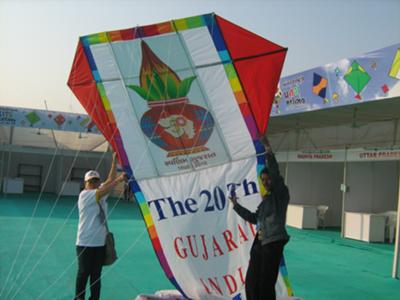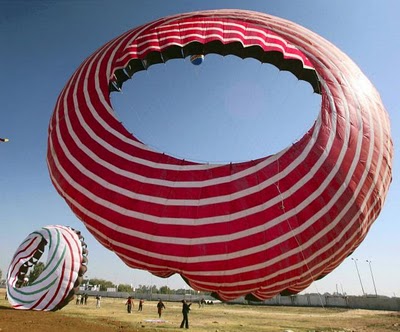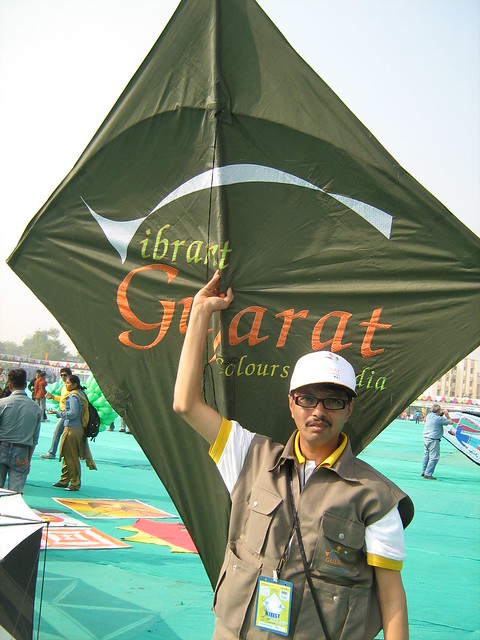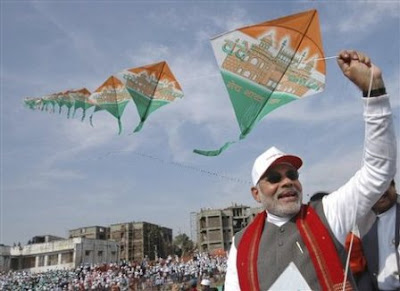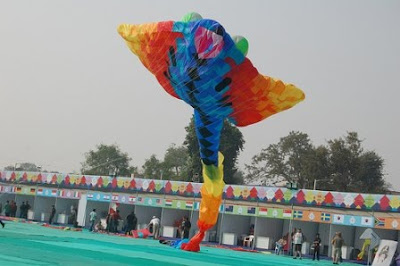International Kite Festival of Ahmedabad, Gujarat, India – festival of Uttarayan or Makar Sankranti
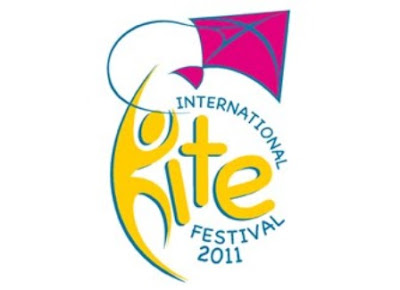
Celebrated In : Ahmedabad, Gujarat .
Held on : 14th January, Every Year.
To Celebrate : Makar Sankranti
Attractions : Colourful kites of sizes and hues.
International Kite Festival is held at Ahmedabad on January 14 every year, to coincide with the festival of Uttarayan or Makar Sankranti. Makar Sankranti is a festival that heralds a change of season marking the movement of the sun into the northern hemisphere – a celebration to mark the end of winter. The skies are blue and clear, a cool breeze blows and a feeling of anticipation, joy and jubilation grips all who celebrate the occasion.
In Gujarat , Makar Sankranti is celebrated as the kite-flying day. Kite-flying day in Gujarat is an extraordinary day, unlike at other places. Ahmedabad, Gujarat ‘s premier city, leads the way in the celebration of Uttarayani, and is the venue of the International Kite Festival.
Kite-flying festival is being held in important cities of
THE BELIEF :
The festival is a time of thanksgiving for the religious, since it marks the awakening of the gods from their long slumber. The gods who are believed to have slumbered for six long months are now awake and the portals of heaven are thrown open. It is also a signal for merry-making.
The temples are thronged with visitors and alms are distributed freely.
KITES OF ALL HUES : From dawn to dusk, people of all ages fly kites rejoicing in the spirit of the day. The blue January sky is enlivened by kites of different colours and hues. Kites soar in the sky, their lines moving as if alive. Crowded rooftops, fun-loving rivalry to outdo each other, and delicious Gujarati feast are the hall-marks of the day. A tremendous variety of kites are seen with friends, neighbours and total strangers indulging in kite fights. The nights see the arrival of the illuminated box kites, often in a series strung on one line, to be launched into the sky. Known as Tukkals, these kites add a touch of splendour to the dark sky.
THE EXPERT TOUCH :
The festival draws expert kite-makers and flyers not only from cities of India
HISTORY OF KITE FLYING :
In fact, kite flying has a fascinating history; man had the desire to fly since time immemorial. It was the spirit of man and his imagination that ultimately saw the invention of kites. Their fascinating history is depicted in the Kite Museum of Ahmedabad.
200 BC : Huein Tsang flew a kite at night to overawe the army of Liu Pang of Han dynasty in china.
100 BC to 500 AD : Kites were used by the army generals to send signals and to measure the distance of enemy camps.
930 AD : The earliest mention of “Shiroshi” in Japanese literature where ‘Shi’ means paper and ‘Roshi’ stands for the Chinese bird.
960 to 1126 AD : Flying kites became a popular activity of recreation in China
1542 AD : For the first time the word ‘ Patang’ finds mention in Indian literature. It was used by Manzan in ‘Madhumalti’, where the flight of a kite is associated with the loved one by a poet.
1752 AD : Benjamin Franklin lofted a kite to prove that lightning was of the same electric matter as the one that generated electricity. Wooden sticks were affixed to four corners of a square silk handkerchief and a projecting metal wire with sharp edge was attached to it. When an electrified cloud passed over the kite, lightning was drawn down through the pointed wire.
1870 AD : Australian inventor Lawrence Hargrave designed box-kites whose stability inspired others to create power driven aeroplanes.
1896 AD : Alexander Graham Bell designed ‘ tetra’ by combining lightweight sticks. He flew ‘Frost King” kite of 256 cells and improvised it to have 1300, and later 3393 cells. At this time, Samuel Cody carried out experiments with man carrying diplane gliders.
1902 AD : Cody’s contemporary, the Wright brothers, were successful in becoming airborne, age of aviation begins.
Kite Festival in India
Kite flying is one of the most popular sports and festival in
Men’s inherent wish to fly high and reach the sky would have surely made him invent the kite and fly it high, somewhere giving him the feeling and the satisfaction that he can fly and touch the sky as high as he wants.
Kite is basically made of paper, though you may also see kites made of silk or other thin material. Kites usually come in various shapes and sizes and framed by a thin bamboo stick. Kites are attached to a thread rolled in a pinball and flown against the direction of the wind. Kite flying is lot of fun but the real excitement lies in cutting in each other’s kites. The more kites you cut the more expert you are.
Kite flying is a festival, which both the class and the mass enjoy. Kite flying is an inexpensive game and can be enjoyed alone or with number of people.
Though there is no fixed time and month for flying kite, different states associate it with different festivals. The most important of all is the Ahmedabad International Kite Festival, which is held in the month of January on the occasion of Makar Sankranti. Expert kite fliers from not only India
Besides, Rakshabandhan and Independence Day are some of the occasions when you can see sky full of colorful kites swaying in the blue skies.
Courtesy : http://www.aryabhatt.com
Courtesy : http://www.aryabhatt.com
Kite Festival Photos
